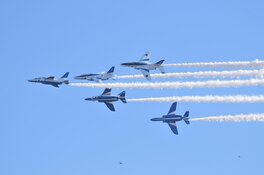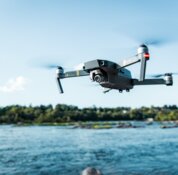DroneShield Ltd. (DRO:ASX; DRSHF:OTC) announced its active participation in Project FlyTrap, a multinational defense exercise led by the United States Army V Corps, which is taking place from June through August 2025 across Germany and Poland. The exercise is designed to advance counter-unmanned aerial systems (CUAS) capabilities in response to the increasing role of aerial threats in modern warfare.
Project FlyTrap features the deployment and evaluation of CUAS technology among NATO allies, including forces from both the United States and the United Kingdom. DroneShield's equipment has been integrated into these exercises, which are being held at the Joint Multinational Readiness Center in Hohenfels, Germany.
DroneShield has been solely focused on CUAS technology for more than a decade and has supplied nearly 4,000 units across over 40 countries. Its technology has been field-tested in live combat environments, including Ukraine, where it was deployed early in the ongoing conflict. This experience has helped solidify DroneShield's position as a contributor to operational defense solutions.
"CUAS is no longer optional. It's essential," said Tom Branstetter, Vice President of Business Development and Sales at DroneShield, in a company news release. "We see exercises like Project FlyTrap as crucial to testing technology before it gets into the warfighter's hands. We're honored that our technology is playing a role in shaping the future of CUAS operations and supporting the mission readiness of our allied forces."
The exercise is being conducted in the context of growing global concerns around drone-based threats, particularly in electronic warfare and cyber-electromagnetic activities. In this environment, CUAS solutions like those provided by DroneShield have been identified as high-priority defense investments by both U.S. and European governments.
Drone and CUAS Technology: A Sector Reinforced by AI and Defense Spending
According to a July 25 article from National Defense, the U.S. Department of Defense has prioritized AI development across numerous defense applications, including drone surveillance, autonomous battlefield assistance, and decision-support tools. Companies have responded by creating flexible AI-driven platforms capable of adapting to new mission demands. Brad Garber of Hidden Level, a company focused on passive sensor systems for drone detection, explained that AI and machine learning helped security leaders "look at potential scenarios" and enabled "a really powerful way to use AI/ML on top of the data we collect."
That report noted that AI's reliability is also being scrutinized through red-teaming, testing systems against varied scenarios to uncover flaws. Kia Khezeli, CEO of YRIKKA, stated that his company was helping the U.S. Army "significantly shorten the development and testing period of new models to ensure their mission readiness." He emphasized that the company's platform could "fine-tune and adapt the models to overcome the detected vulnerabilities post-red-teaming."
On July 25, DroneLife highlighted how advances in drone technology have grown out of both commercial and military innovation. Performance Drone Works (PDW), which originated in drone racing, shifted to developing battle-ready UAVs. The company's co-founder, Ryan Gury, said PDW designed small drones capable of ISR (intelligence, surveillance, reconnaissance) missions and electronic warfare, with a focus on affordability and effectiveness. The company's new FPV combat drone, the AM-FPV, was priced at around US$5,000 and equipped with automatic target recognition and AI capabilities.
Gury explained that PDW's technologies were designed to meet the battlefield needs of soldiers. "We're able to deliver on requirements that civilians cannot," he said. The company also built its own secure communication systems, evolving from its background in first-person-view drone racing.
A July 31 report from FinancialNewsMedia described a supportive investment climate for U.S.-based drone companies, citing a wave of legislative and executive actions that aligned procurement mandates with domestic manufacturing. The report stated, "The strengthened investment environment for U.S. drone companies in the summer of 2025 is a direct response to aggressive legislative and executive action." These actions reportedly influenced both public and private investment into drone companies, accelerating the development of AI and autonomous capabilities.
As FinancialNewsMedia also noted, U.S. policy changes contributed to a sector-wide rise in capital availability and stock valuations, reflecting a growing interest in the drone industry's relevance to national defense. "This unique interplay of policy and market forces is not only revitalizing the American drone industrial base but is also driving a more resilient, innovation-focused sector," the report added.
Analysts Maintain Buy Ratings as DroneShield Secures Global Traction
On July 30, Bell Potter upgraded DroneShield to a Buy rating from Hold and cited improved near-term outlook following the company's Q2 results. Analysts Daniel Laing and Baxter Kirk reported that DroneShield delivered Q2 revenue of AU$38.8 million, up 15.8% from the previous quarter, and free cash flow of AU$8.2 million. They wrote that the company's record quarterly performance and strengthened balance sheet "reinforces confidence in DRO's 2H25 trading outlook." Bell Potter also highlighted the company's backlog of AU$104 million and pipeline of AU$2.3 billion as supporting the positive reassessment.
That same day, Shaw and Partners reaffirmed a Buy rating on DroneShield and r increased its valuation of the company to AU$3.60 per share. The Shaw report, authored by analyst Abraham Akra, highlighted DroneShield's strong contract momentum and global expansion strategy, including planned contract manufacturing regional hubs in the United States and Europe. It stated that DroneShield's proprietary software suite and AI capabilities provided a competitive advantage, describing the company as "well-positioned to benefit from the increasing demand for integrated CUAS solutions across defense and critical infrastructure sectors." According to the report, DroneShield was "now seen as a primary provider in multiple government and military procurement channels."
Operational Momentum and Industry Position
DroneShield's participation in Project FlyTrap aligns with the company's ongoing momentum in the counterdrone sector. According to its July 2025 investor presentation, the company reported US$72.3 million in half-year revenue for HY2025, representing a 210% increase over the same period in 2024. In the second quarter alone, revenue reached US$38.8 million, a 480% year-over-year rise.
The company's secured revenues for the year to date reached US$176.3 million as of July 22, 2025 - more than triple the total revenue for all of 2024. DroneShield's current sales pipeline stands at US$2.33 billion, encompassing projects across Europe, the United States, Asia, and Australia.
The firm continues to invest more than US$50 million annually into research and development, with a growing emphasis on AI-powered detection and defeat systems. Its solutions span dismounted, vehicle-mounted, and fixed-site deployments, and integrate sensors including radar, acoustic, optical, and radiofrequency components.
The company's proprietary AI software, such as DroneSentry-C2, enables real-time detection, tracking, and mitigation of drone threats. These tools are integrated into the broader defense architecture of its customers, allowing for rapid deployment and operational adaptability.
DroneShield has also been expanding its global footprint, with plans to establish new regional manufacturing and sales hubs in Europe and the United States. Its technology has applications beyond military environments, including in government infrastructure, critical energy sites, airports, and correctional facilities.
 Streetwise Ownership Overview*
Streetwise Ownership Overview*
DroneShield Ltd. (DRO:ASX; DRSHF:OTC)
As Project FlyTrap continues through August, DroneShield's role in these joint exercises reflects its established presence in the evolving CUAS landscape and ongoing collaboration with major defense partners.
Ownership and Share Structure
Recent filings reveal that Vanguard Group has become a substantial shareholder in DroneShield, holding a 5.45% stake, and Fidelity Management and Research holds approximately 9.59%.
Management and insiders hold around 5.06%, according to the most recent company presentation.
DroneShield has 874.61 million outstanding shares and 862.8 million free float traded shares. Its market cap is approximately AU$3.2 billion, and its sales pipeline has grown to AU$2.3 billion.
The company's 52-week share price range is AU$0.5850 to US$4.10.
Want to be the first to know about interesting Technology investment ideas? Sign up to receive the FREE Streetwise Reports' newsletter.
Subscribe
Important Disclosures:
- As of the date of this article, officers and/or employees of Streetwise Reports LLC (including members of their household) own securities of Droneshield.
- James Guttman wrote this article for Streetwise Reports LLC and provides services to Streetwise Reports as an employee.
- This article does not constitute investment advice and is not a solicitation for any investment. Streetwise Reports does not render general or specific investment advice and the information on Streetwise Reports should not be considered a recommendation to buy or sell any security. Each reader is encouraged to consult with his or her personal financial adviser and perform their own comprehensive investment research. By opening this page, each reader accepts and agrees to Streetwise Reports' terms of use and full legal disclaimer. Streetwise Reports does not endorse or recommend the business, products, services or securities of any company.
For additional disclosures, please click here.








































